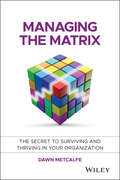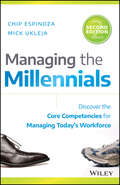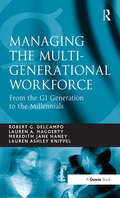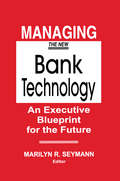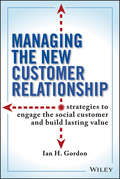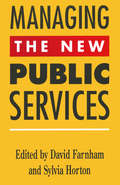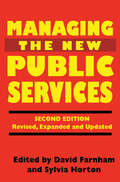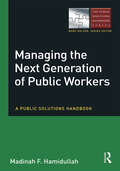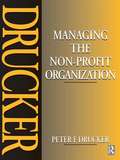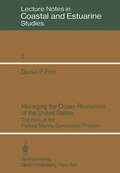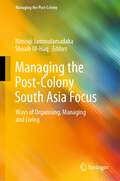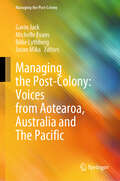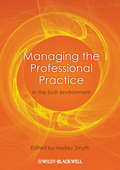- Table View
- List View
Managing the Matrix: The Secret to Surviving and Thriving in Your Organization
by Dawn MetcalfeA comprehensive guide to excelling in a complex matrix organization Debra was not in a good mood as she entered Johann’s office for their third meeting. One of her colleagues had just been promoted and, although the guy who got it was good, she didn’t think he was any better than her. Well, except at one thing, he was always playing politics - sucking up to the more senior guys and volunteering to be on any committee going. Debra knew the type - went to the same school, belonged to the same club - she didn’t have a hope against the kind of connections he had so she might as well give up. It seemed doing a good job just wasn’t enough around here. Debra and Johann work in an environment with multiple and complex reporting lines – in other words, a matrix. There’s room to “slip between the cracks” – if a person wants to take advantage of confusion over who is managing performance; or if they can’t make the necessary transition to self-management. Communication can be difficult even when there is an apparently shared language. Read how Johann and Debra work together to identify the skills needed to succeed in a matrix, and how using Emotional Intelligence (EI) can develop specific behaviours you can incorporate in your daily job. The result will help reduce stress and increase your chances of success. Dawn Metcalfe, Managing Director of PDS, based in Dubai, uses her experience as a coach and trainer to give us a behind the curtain look at how mentoring can help an individual develop the skills they need to survive and thrive in today’s complex work environments.
Managing the Millennials: Discover the Core Competencies for Managing Today's Workforce
by Chip Espinoza Mick UklejaThe Builders, Baby Boomers, Generation X, and Millennials—all make up workforces in every type of industry all over the world. The generational gaps are numerous and distinctly different between each age group, and Millennials have gotten a reputation for being particularly unique and often challenging. In this updated and expanded Second Edition of the popular guidebook Managing the Millennials, you'll see how Millennial traits are the same around the globe. In fact, Millennials are more alike than any other generation before them due in large part to rapid advances in technology that let us share more experiences together. These same rapid advances are also redefining the fundamental ways businesses operate, and this revised edition includes the international perspective today's valuable leadership needs to attract and retain these high-performing workers with very different values and expectations. With fresh research and new real-world examples, the powerhouse authorial team reexamines the differences between how different generations work today in businesses around the world, with insightful exploration into what makes the Millennial generation so different from the ones that came before. The authors reveal nine specific points of tension commonly arising from clashing value systems among generations and prescribe nine proven solutions to resolve conflict and build communication, nurture collaborative teams, and create long-lasting relationships among colleagues of every age. A wealth of informative tables and convenient end-of-chapter summaries make this an invaluable everyday reference to support you: Making the most informed decisions with up-to-date, research-based guidance on getting the most from twenty-something employees Executing solutions to the most common obstacles to younger workers engaging and learning from the people who manage them Enhancing your skills as a job coach with practical tips and hands-on tools for coaching Millennials, including concrete action steps for overcoming roadblocks Complete with case studies of real managers and employees interacting in every area of business, enlightening analysis of performance and behavioral patterns across generations, and easy-to-use techniques you can use right away to improve your organization, Managing the Millennials, Second Edition gives you everything you need to inspire your entire workforce to new levels of productivity.
Managing the Millennials: Discover the Core Competencies for Managing Today's Workforce
by Chip Espinoza Mick UklejaThe Builders, Baby Boomers, Generation X, and Millennials—all make up workforces in every type of industry all over the world. The generational gaps are numerous and distinctly different between each age group, and Millennials have gotten a reputation for being particularly unique and often challenging. In this updated and expanded Second Edition of the popular guidebook Managing the Millennials, you'll see how Millennial traits are the same around the globe. In fact, Millennials are more alike than any other generation before them due in large part to rapid advances in technology that let us share more experiences together. These same rapid advances are also redefining the fundamental ways businesses operate, and this revised edition includes the international perspective today's valuable leadership needs to attract and retain these high-performing workers with very different values and expectations. With fresh research and new real-world examples, the powerhouse authorial team reexamines the differences between how different generations work today in businesses around the world, with insightful exploration into what makes the Millennial generation so different from the ones that came before. The authors reveal nine specific points of tension commonly arising from clashing value systems among generations and prescribe nine proven solutions to resolve conflict and build communication, nurture collaborative teams, and create long-lasting relationships among colleagues of every age. A wealth of informative tables and convenient end-of-chapter summaries make this an invaluable everyday reference to support you: Making the most informed decisions with up-to-date, research-based guidance on getting the most from twenty-something employees Executing solutions to the most common obstacles to younger workers engaging and learning from the people who manage them Enhancing your skills as a job coach with practical tips and hands-on tools for coaching Millennials, including concrete action steps for overcoming roadblocks Complete with case studies of real managers and employees interacting in every area of business, enlightening analysis of performance and behavioral patterns across generations, and easy-to-use techniques you can use right away to improve your organization, Managing the Millennials, Second Edition gives you everything you need to inspire your entire workforce to new levels of productivity.
Managing the Multi-Generational Workforce: From the GI Generation to the Millennials
by Robert G. DelCampo Lauren A. Haggerty Lauren Ashley KnippelFor the first time in history, four distinct and very different generations are working together. Generational conflict is one of the last bastions of acceptable discrimination in today's workplace. Each generation has different beliefs, expectations, values, learning styles, and desires. These result in a strong tendency for them to adopt different work habits. Managing employees of several generations is not an easy task, but it is the reality of the business world today. The creation of a culture and coordinating programs that foster communication and collaboration between all of the generations present in the workforce will help to alleviate the difficulties managers may encounter. In order to truly create a cohesive workplace, managers must encourage employees to view generational difference as a valuable strength rather than a weakness. Based on rigorous academic research, Managing the Multi-Generational Workforce identifies the characteristics of the different generations, considers their expectations and values, and how these influence the way they relate to each other. The authors then examine implications for organizational culture and structures, recruitment and retention tactics, training, and management styles and approaches. This book actually tackles the issue of properly integrating the newest generation - the 'Millennials', into the workforce and challenges the unrealistic belief that all that needs to happen is for younger generations to be 'changed' to conform to workforce norms. As younger generations enter the workforce, and eventually dominate it, workforce norms will change. Any firm or manager competing in today's war for top talent will find this book indispensable.
Managing the Multi-Generational Workforce: From the GI Generation to the Millennials
by Robert G. DelCampo Lauren A. Haggerty Lauren Ashley KnippelFor the first time in history, four distinct and very different generations are working together. Generational conflict is one of the last bastions of acceptable discrimination in today's workplace. Each generation has different beliefs, expectations, values, learning styles, and desires. These result in a strong tendency for them to adopt different work habits. Managing employees of several generations is not an easy task, but it is the reality of the business world today. The creation of a culture and coordinating programs that foster communication and collaboration between all of the generations present in the workforce will help to alleviate the difficulties managers may encounter. In order to truly create a cohesive workplace, managers must encourage employees to view generational difference as a valuable strength rather than a weakness. Based on rigorous academic research, Managing the Multi-Generational Workforce identifies the characteristics of the different generations, considers their expectations and values, and how these influence the way they relate to each other. The authors then examine implications for organizational culture and structures, recruitment and retention tactics, training, and management styles and approaches. This book actually tackles the issue of properly integrating the newest generation - the 'Millennials', into the workforce and challenges the unrealistic belief that all that needs to happen is for younger generations to be 'changed' to conform to workforce norms. As younger generations enter the workforce, and eventually dominate it, workforce norms will change. Any firm or manager competing in today's war for top talent will find this book indispensable.
Managing the New Bank Technology: An Executive Blueprint for the Future
by Marilyn R. SeymannManaging the New Bank Technology is a practical action-oriented guide for bank CEOs, executives, business students, and boards. The book is aimed at educating those involved in banking on the key technological issues facing the industry. "Quick reference" guides opening each chapter are a special feature of the book, blueprints that offer bottom line summary suggestions for bank officers and executives. Topics include: Banking as Retailing; The Internet and Financial Services; Strategies for Future Payment Systems; Risk Management Technology; Protecting Technology Investments in an Age of Rapid Change; Negotiating Outsourcing Contracts; Developing an Information System Plan; Organizational Strategies to Manage Technology; Battling Fraud and Security Issues; and Selling Your Bank's Technology Vision.
Managing the New Bank Technology: An Executive Blueprint for the Future
by Marilyn R. SeymannManaging the New Bank Technology is a practical action-oriented guide for bank CEOs, executives, business students, and boards. The book is aimed at educating those involved in banking on the key technological issues facing the industry. "Quick reference" guides opening each chapter are a special feature of the book, blueprints that offer bottom line summary suggestions for bank officers and executives. Topics include: Banking as Retailing; The Internet and Financial Services; Strategies for Future Payment Systems; Risk Management Technology; Protecting Technology Investments in an Age of Rapid Change; Negotiating Outsourcing Contracts; Developing an Information System Plan; Organizational Strategies to Manage Technology; Battling Fraud and Security Issues; and Selling Your Bank's Technology Vision.
Managing the New Customer Relationship: Strategies to Engage the Social Customer and Build Lasting Value
by Ian GordonPraise for MANAGING THE NEW CUSTOMER RELATIONSHIP “Gordon delivers an impressive synthesis of the newest methods for engaging customers in relationships that last. No organization today can succeed without the mastery of customer relationship management strategy fundamentals. But to win in the decades ahead, you must also understand and capitalize on the rapidly evolving social computing, mobility and customer analytics technologies described in this book. Checklists, self-assessments and graphical frameworks deliver pragmatic value for the practicing manager.” — William Band, Vice-President, Principal Analyst, Forrester Research Inc., Cambridge, MA
Managing the New Customer Relationship: Strategies to Engage the Social Customer and Build Lasting Value
by Ian GordonPraise for MANAGING THE NEW CUSTOMER RELATIONSHIP “Gordon delivers an impressive synthesis of the newest methods for engaging customers in relationships that last. No organization today can succeed without the mastery of customer relationship management strategy fundamentals. But to win in the decades ahead, you must also understand and capitalize on the rapidly evolving social computing, mobility and customer analytics technologies described in this book. Checklists, self-assessments and graphical frameworks deliver pragmatic value for the practicing manager.” — William Band, Vice-President, Principal Analyst, Forrester Research Inc., Cambridge, MA “A very comprehensive and practical book on managing relationships with existing customers in the age of social media! I particularly enjoyed reading chapters on teaching customers new behaviors, which were illustrated by excellent case studies.” — Jagdish N. Sheth, Ph.D. , Charles H. Kellstadt Professor of Marketing, Emory University, Atlanta, GA “The strategic breadth and depth of this book is impressive as Gordon explores the new customer and how to plan and manage the new customer relationship. I found his review of strategies, techniques and technologies for social, mobile, mass customization and customer analytics to be particularly insightful. Gordon urges marketers to live and breathe one-through-one marketing and to master social engagement techniques. The checklists, cases and examples make the content grounded and actionable. This is an important, current and detailed book to which every organization should pay close attention to improve customer relationships and create shareholder value.” — Marcus Ruebsam, Vice-President, Line-of-Business Marketing Solutions, SAP AG, Walldorf, Germany “There are many books on CRM, but I recommend this one because Gordon’s book does what others do not. He considers CRM strategy and evolves it to recognize a new customer, one who is always connected, socially available and influential. The book doesn’t just discuss many point solutions for specific marketing challenges; it integrates technology with strategy, people, process and customer analytics to develop relationships continuously. This book is a broad and deep exploration of CRM, providing practical, fact-based perspectives that every company can use to validate and rethink their customer and stakeholder relationships.” — Helmuth Cepeda, Small, Medium and Distribution Director, Microsoft Mexico, Mexico City, Mexico Marketing has changed fundamentally in the last few years and has become an entirely new discipline, one that focuses on a new customer and a new relationship, framed by new principles, strategies, processes, roles and tactics. Individual customers are economically targeted and served, and treated as segments of one rather than members of a target market. Word of mouth and recommendations are vital as customers influence one another more than a company can do within its own advertising or customer dialogs. Today’s customer is always online, accessible and connected. Now marketing is not only direct and customer-specific but a continuous process by which companies seek to engage customers and be progressively more relevant, attractive and valuable. This is the era of a new customer relationship—an individual relationship that is social, mobile and local, influenced by peers and shaped by cognitive, behavioural and social psychological principles. New techniques, processes and technologies transform what it means to implement marketing strategy and achieve improved business results. The new customer relationship requires that even those companies t
Managing the New Generation
by Carolin Rekar MunroThis book is written to help managers and business leaders harness the talent and skills of Gen Y.
Managing the New Public Services
by Daniel Farnham Sylvia HortonThis volume provides an introduction to, and assessment of, the major organizational changes in Britain's public services since the late 1970s which have collectively been identified as the emergence of a "new managerialism".
Managing the New Public Services
Managing the New Public Services evaluates managerial changes in British public services since 1979 focusing on the 'New Public Management' and its rationale and practices. The authors analyse the political origins of public service change and its impact on the key managerial functions, on service-users and on staff. The second edition has been thoroughly revised and updated throughout. Several chapters have been completely rewritten and new chapters have been added on Marketing and Information and Communications.
Managing the Next Generation of Public Workers: A Public Solutions Handbook (The Public Solutions Handbook Series)
by Madinah F HamidullahManaging the Next Generation of Public Workers is a fresh and energetic look at the changing climate of diversity in the public and nonprofit workplace. The workforce of the twenty-first century represents unparalleled complexity: Baby Boomers, GenX, GenY, and Millennials. Although that diversity may be challenging and often overwhelming for public managers, Madinah Hamidullah emphasizes the potential strengths that can be drawn from complex multigenerational relationships. This handbook offers public and nonprofit managers the tools necessary to address generational differences and questions such as: • How do the newer generations in the workplace differ on such fundamentals as work ethic, family values, and retirement horizons? • Are they recruited differently and do they expect a different mix of benefits—perhaps a better work-life balance as a tradeoff for a lower salary? • How can diverse, generational perspectives in the workplace add value by questioning old, traditional assumptions? • Will approaches to organizational decision making necessarily change as new generations take over? The book is for public and nonprofit managers who recognize the challenges of managing a multigenerational workforce, and are therefore seeking helpful insights. This volume is a roadmap not only for human resource (HR) managers, but for all managers who must address the complexities of the human condition—complexities that are complicated by the most rapid succession of workforce generations that we have yet seen.
Managing the Next Generation of Public Workers: A Public Solutions Handbook (The Public Solutions Handbook Series)
by Madinah F HamidullahManaging the Next Generation of Public Workers is a fresh and energetic look at the changing climate of diversity in the public and nonprofit workplace. The workforce of the twenty-first century represents unparalleled complexity: Baby Boomers, GenX, GenY, and Millennials. Although that diversity may be challenging and often overwhelming for public managers, Madinah Hamidullah emphasizes the potential strengths that can be drawn from complex multigenerational relationships. This handbook offers public and nonprofit managers the tools necessary to address generational differences and questions such as: • How do the newer generations in the workplace differ on such fundamentals as work ethic, family values, and retirement horizons? • Are they recruited differently and do they expect a different mix of benefits—perhaps a better work-life balance as a tradeoff for a lower salary? • How can diverse, generational perspectives in the workplace add value by questioning old, traditional assumptions? • Will approaches to organizational decision making necessarily change as new generations take over? The book is for public and nonprofit managers who recognize the challenges of managing a multigenerational workforce, and are therefore seeking helpful insights. This volume is a roadmap not only for human resource (HR) managers, but for all managers who must address the complexities of the human condition—complexities that are complicated by the most rapid succession of workforce generations that we have yet seen.
Managing the Non-Profit Organization
by Peter DruckerA Drucker management classic, first published in 1990, which breaks down any narrow definition of management and is aimed specifically at decision-makers and managers working in non-profit making and charitable organizations to help them apply the principles of good management to their sector. Drawing from the American experience, Drucker poignantly illustrates his discussion of management by quoting his in-depth interviews with top executives from non-profit making organizations. The issues of mission, performance, people and relationships, leadership and developing managers are eloquently discussed and Drucker provides Action Implications throughout the book which are of practical importance to the reader.
Managing the Non-Profit Organization: Principles And Practices
by Peter DruckerA Drucker management classic, first published in 1990, which breaks down any narrow definition of management and is aimed specifically at decision-makers and managers working in non-profit making and charitable organizations to help them apply the principles of good management to their sector. Drawing from the American experience, Drucker poignantly illustrates his discussion of management by quoting his in-depth interviews with top executives from non-profit making organizations. The issues of mission, performance, people and relationships, leadership and developing managers are eloquently discussed and Drucker provides Action Implications throughout the book which are of practical importance to the reader.
Managing the Ocean Resources of the United States: The Role of the Federal Marine Sanctuaries Program (Coastal and Estuarine Studies #2)
by Daniel P. FinnFederal programs applicable to the oceans and coastal zone have evolved incrementally in response to perceived needs to expedite emerging mari time development while conserving valuable marine resources. As a re sult, the current federal marine effort is divided among a plethora of programs administered by a number of agencies within different Depart ments. The programs themselves are conducted under the authority of multiple statutes with varying reaches and objectives: as a result they often overlap and conflict. There is no assurance, moreover, that the coverage of federal programs is complete in scope or comprehensive in conception. No single institutional device can ensure that these pro grams will manage the marine resources of the United States consistent ly and comprehensively, so as to derive maximum public benefit. While the present maze of statutes, regulations, and executive directives may in theory provide opportunities for a wide-ranging consideration of all relevant factors prior to making specific decisions, there can be no guarantee that this objective is realized either systematically or rea sonably effectively. Recent political developments indicate that the structure of federal marine programs will continue to be subject to scrutiny for some time. President Reagan's emphases on economic deregulation and development of outer continental shelf (OCS) oil and gas resources may lead to stream lining the OCS leasing and permitting process and altering the execu tion of the federal multiple use policy for marine areas.
Managing the Olympics
by Stephen Frawley and Daryl AdairThe Olympic Games are the world's most complex and challenging sport mega-event to organize. Managing the Olympics is the first ever attempt to bring together the world's leading Olympic management researchers in one book and draws on the latest research into the management challenges faced by the organizers and key stakeholders of the Games.
Managing the Paralympics
by Simon Darcy Daryl Adair Stephen FrawleyThis book critically examines the planning, management, and operations of the world’s premier event for Para sport athletes. Noting a lack of research into how these games are planned and managed, the authors of this contributed volume discuss how the Paralympics are essentially different to the Olympics and what this means for their management. Managing the Paralympics explores how the organizers and connected stakeholders effectively organize and deliver the Paralympics, taking into account what has been learned from previous events. Including emergent models of best practice from event management, project management and sport management literature, the book gives an insight into the planning of one of the world’s biggest sporting events that encompasses ten impairment types and multiple sport classes within sports.
Managing the Post-Colony South Asia Focus: Ways of Organising, Managing and Living (Managing the Post-Colony)
by Nimruji Jammulamadaka Shoaib Ul-HaqThis edited book on South Asia is part of the book series “Managing the Post-colony.” This series is co-edited by Nimruji Jammulamadaka and Gavin Jack and is focused on managing and organising within the historical and contemporary structures of colonization and imperialism within and across nation-states and social domains especially the economic and the cultural domain. This edited book on South Asia is committed to a presentation of indigenous understandings and knowledge around the organizing, religion, language and cultural production through the lens of anti, post and de-colonial thought. This book forces the reader to consider not just what we know but how and where we know and can be instrumental in identifying and challenging dominant modes of management knowledge production. The decolonial movement is closely associated with scholars like Walter Mignolo, Anibal Quijano and others who expose how Western rationality and science, emanating from the enlightenment project, are being used by colonial powers to consolidate their imperial projects. The authors in this book argue that a potent form of colonization is epistemic in nature. This book series seeks to present cutting-edge, critical, interdisciplinary, and geographically and culturally diverse perspectives on the contemporary nature, experience and theorization of managing and organizing in post-colonial location under conditions of coloniality. These conditions subsume ongoing and new forms of colonisation/imperialism, and complex resistances to them, and lives lived outside them, and may be drawn out and investigated in regard to a multiplicity of different business- and management-related topics.The power of domination is its ability to silence other ways of knowing, being and doing. Focus on South Asia: Ways of Managing, Organising and Living delivers a profound critique of Western management theory and its universalistic claims. But, it goes much further to advance other managements and ways of organising from the peoples and communities of South Asia. Stella M. Nkomo, University of Pretoria, South Africa I like very much the orientation and the composition of the volume…you have a) the meaning of management in the West changed after the Industrial revolution and by 1900 became a political issue domestically in the US and before that colonial, as you show in the colonial context of South Asia; b) so the constitution of the settler management as you show with McCaulay, destituted all existing local form of organizing their praxis of living; c) the task now is the reconstitution of the destituted, the pluriversal human (and animals too) self-organization subjected to Western regulations to their own benefit, while materializing their rhetoric of racial destitution (incapable of organizing like us, impossible for them to be like, us we have to teach them civilization, etc.). Walter Mignolo, William H. Wannamaker Professor of Literature and Romance Studies at Duke University, USA Very Impressive and Much Needed Pushkala Prasad, Zankel Chair Professor, Skidmore College.
Managing the Post-Colony: Voices from Aotearoa, Australia and The Pacific (Managing the Post-Colony)
by Gavin Jack Michelle Evans Billie Lythberg Jason MikaThis edited book is the second in the book series “Managing the Post-Colony”. The book series is co-edited by Nimruji Jammulamadaka (IIM Calcutta, India) and Gavin Jack (Monash University, Australia). The book series seeks to present cutting-edge, critical, interdisciplinary, and geographically and culturally diverse perspectives on the contemporary nature, experience, and theorisation of managing and organising under conditions of postcoloniality. This book specifically presents voices and perspectives from Aotearoa New Zealand, Australia, and The Pacific, locations with shared and distinctive histories and present-day experiences of colonisation and imperialism. Ways of managing, organising, and doing business in these places demonstrate cultural continuity and change in such histories, present sites of postcolonial struggle, and diverse prospects for self-determined future-making. The book explores struggles and prospects of managing in the post-colony through qualitative empirical cases, historical and legal studies, conceptual essays and provocations, and interviews with Indigenous business leaders. It contributes to the ongoing diversification, provincialisation, and decolonisation of management and organisation studies and practice. A strong focus is placed on diverse Indigenous knowledges and experiences, including those of Aboriginal and Torres Strait Islander, Pasifika, and Māori peoples, and insights into the capacity for Indigenous culture-specific modes of business to offer decolonising futures.
Managing the Professional Practice: In the Built Environment
by Hedley SmythThe emphasis here is to explore the key issues influencing the culture, strategies and management operations of professional practices. The focus is upon established practices from growing ones to large international firms in the built environment. A key aim of the book is to promote aspects of management by function and activities, with discipline acting as context rather than the primary focus. The book is structured into sections around 3 main themes: managing the organisation; and managing specific issues that affect operations, and a third section reflects upon management from practitioner experience. Section I: 'Managing the organisation' looks at how the history of the firm creates both opportunities and rigidities for developing the practice, in terms of culture and market position, strategies and implementation, financial, marketing and HR management. Section II: 'Managing specific strategic and tactical issues' looks at how these affect approaches a discipline and operational processes in practices. These issues compliment those covered in Section I. Section III: 'Reflecting on practice' covers experience of those in practice and top practitioners detail how they are addressing key issues in their practice and for their discipline. Each chapter by a practitioner has a postscript from academic authors to make links back to research on theory and application. Addresses the key issues facing practice managers Collects latest research from leading academics Offers comment on current practice from top practitioners
Managing the Professional Practice: In the Built Environment
by Hedley SmythThe emphasis here is to explore the key issues influencing the culture, strategies and management operations of professional practices. The focus is upon established practices from growing ones to large international firms in the built environment. A key aim of the book is to promote aspects of management by function and activities, with discipline acting as context rather than the primary focus. The book is structured into sections around 3 main themes: managing the organisation; and managing specific issues that affect operations, and a third section reflects upon management from practitioner experience. Section I: 'Managing the organisation' looks at how the history of the firm creates both opportunities and rigidities for developing the practice, in terms of culture and market position, strategies and implementation, financial, marketing and HR management. Section II: 'Managing specific strategic and tactical issues' looks at how these affect approaches a discipline and operational processes in practices. These issues compliment those covered in Section I. Section III: 'Reflecting on practice' covers experience of those in practice and top practitioners detail how they are addressing key issues in their practice and for their discipline. Each chapter by a practitioner has a postscript from academic authors to make links back to research on theory and application. Addresses the key issues facing practice managers Collects latest research from leading academics Offers comment on current practice from top practitioners
Managing the Psychological Contract: Employee Relations in South Asia
by Abm AbdullahThis book explores the differences between Western and non-Western cultures to provide a more comprehensive understanding of psychological contract and its consequences on employees’ behavioral, attitudinal, and cognitive outcomes. Further, it discusses the culturally-relevant elements of HR practices that affect employee expectations, job satisfaction, commitment, and motivation based on their perceptions of the level of fulfilment of their psychological contract. Integrating both qualitative and quantitative methods, it is the first book to examine the current state of the South Asian workforce and will advance research on industrial relations, employee relationship management, and corporate management of South Asian employees around the world.
